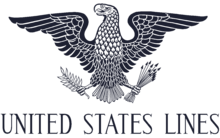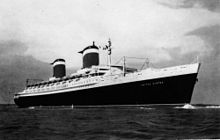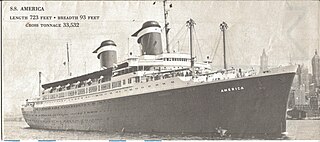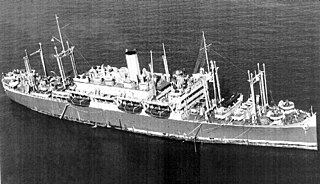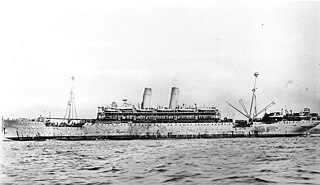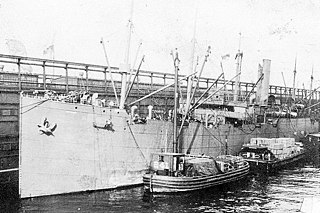| Name | Years Active for USL | Notes |
|---|
| Acadia | 1939 | Chartered from Eastern SS Lines for one voyage [28] |
| SS America (1905) | 1920-1931 | former Amerika |
| SS America (1940) | 1940-41, 1946-1964 | USS West Point (1941-1946) Wrecked at Playa de Garcey on Fuerteventura in the Canary Islands in 1994. Subsequently destroyed. |
| SS American Accord | 1970-1986 | Type C6-S-1w container ship, IMO 5278901, converted from C4-S-1a cargo ship Pioneer Moor, originally Sunflower Mariner, 1954 |
| SS American Ace | 1970-1986 | Type C6-S-1w container ship, IMO 5278963, converted from C4-S-1a cargo ship Pioneer Mart, originally Mountain Mariner, 1953 |
| MV American Alabama | 1984-1987 | Econship container ship, IMO 8212647 |
| SS American Alliance | 1970-1987 | Type C6-S-1w container ship, IMO 5278913, converted from C4-S-1a cargo ship Pioneer Mill, originally Show Me Mariner, 1954 |
| SS American Altair | 1982-1987 | Partial container ship, IMO 6421347, originally C4-S-60a Mormacaltair, 1964 |
| SS American Apollo | 1970-1988 | Type C7-S-68e container ship, IMO 7025269 |
| SS American Aquarius | 1971-1988 | Type C7-S-68e container ship, IMO 7042485 |
| SS American Archer | 1970-1986 | Type C6-S-1w container ship, IMO 5278949, converted from C4-S-1a cargo ship Pioneer Mist, originally Peninsula Mariner, 1954 |
| SS American Argo | 1982-1986 | Partial container ship, IMO 6407949, originally C4-S-60a Mormacargo, 1964 |
| SS American Argosy | 1970-1986 | Type C6-S-1w container ship, IMO 5278896, converted from C4-S-1a cargo ship Pioneer Main, originally Cotton Mariner, 1953 |
| SS American Astronaut | 1969-1988 | Type C7-S-68e container ship, IMO 6916861 [29] |
| SS American Banker | 1985-1987 | 1972 Converted container ship, IMO 5277153, [30] originally C5-S-75a Philippine Mail, 1962 |
| SS American Builder | 1985-1987 | 1971 Converted container ship, IMO 5386605, originally C5-S-75a Washington Mail, 1961 |
| MV American California | 1985-1987 | Econship container ship, IMO 8212702 |
| SS American Challenger | 1962-1988 | Type C4-S-57a cargo ship, IMO 5014252 |
| SS American Charger | 1962-1988 | Type C4-S-57a cargo ship, IMO 5014276 |
| SS American Champion | 1963-1987 | Type C4-S-57a cargo ship, IMO 5014264 |
| SS American Chieftain | 1963-1988 | Type C4-S-57a cargo ship, IMO 5400528 |
| SS American Commander | 1963-1967 | Type C4-S-57a cargo ship, [31] IMO 5014305 |
| SS American Contender | 1964-1967 | Type C4-S-57a cargo ship, [31] IMO 5410119 |
| SS American Contractor | 1964-1967 | Type C4-S-57a cargo ship [31] |
| SS American Corsair | 1963-1967 | Type C4-S-57a cargo ship, [31] IMO 5014317 |
| SS American Clipper | 1945- | Type C2-S-AJ5 |
| SS American Counselor | | |
| SS American Courier | 1963-1986 | Type C4-S-57a cargo ship [31] |
| SS American Crusader | 1964-1967 | Type C4-S-57a cargo ship, [31] INO 6404997 |
| SS American Defender | 1948-1956 | ex-Fordham Victory. [32] |
| SS American Draco | 1982-1987 | Partial container ship, IMO 6507921, originally C4-S-60a Mormacdraco, 1965 |
| SS American Entente | 1983-1987 | Type C6-S-85a container ship, IMO 7326233, originally Austral Entente, 1972 |
| SS American Envoy | 1983-1987 | Type C6-S-85a container ship, IMO 7116315, originally Austral Envoy, 1972. Now Matson Navigator, 2016. |
| SS American Farmer | 1924-1940 | |
| SS American Flyer | 1946-1964 | Type C2-S-B1 cargo ship [33] |
| MV American Georgia | 1985-1987 | Container ship, IMO 8200711 |
| MV American Hawaii | 1984-1987 | Ro-Ro/Container ship, IMO 8320559 |
| SS American Hunter | | |
| MV American Illinois | 1985-1987 | Econship container ship, IMO 8212697 |
| SS American Importer | 1931 | Ex troopship Somme (1920) originally Design 1024 built Hog Island, renamed American Importer converted United Dry Docks, Brooklyn. 1940 Ville de Gand torpedoed and lost [34] [35] |
| MV American Kentucky | 1985-1987 | Econship container ship, IMO 8212661 |
| SS American Lancer | 1969-1987 | Type C7-S-68c container ship, [29] IMO 6708379 |
| SS American Lark | 1969-1987 | Type C7-S-68d container ship, [29] IMO 6905252 |
| MS American Leader | 1941-1942 | Type C1-B cargo ship |
| SS American Leader (2) | 1946-1970 | Type C2-S-B1 cargo ship, ex-Twilight [32] |
| SS American Leader (3) | 1970-1986 | Type C6-S-1w container ship, IMO 5278937, converted from C4-S-1a cargo ship Pioneer Minx, originally Gopher Mariner, 1953 |
| SS American Legacy | 1970-1986 | Type C6-S-1w container ship, IMO 5278925, converted from C4-S-1a cargo ship Pioneer Ming, originally Silver Mariner, 1954 |
| SS American Legend | 1970-1986 | Type C6-S-1w container ship, IMO 5278975, converted from C4-S-1a cargo ship Pioneer Myth, originally Pelican Mariner, 1954 |
| SS American Legion | 1968-1987 | Type C7-S-68c container ship, [29] IMO 6812211 Flagship after the retirement of SS United States. Later Horizon Challenger. |
| SS American Liberty | 1968-1988 | Type C7-S-68d container ship, [29] IMO 6820579 Later Horizon Discovery. |
| SS American Lynx | 1968-1988 | Type C7-S-68d container ship, [29] IMO 6828624 |
| MV American Maine | 1984-1987 | Econship container ship, IMO 8212635 |
| SS American Marketer | 1983-1987 | Type C6-S-85a container ship, IMO 7218462, originally Austral Ensign, 1973. Later Horizon Fairbanks, laid up 2015. |
| SS American Merchant | 1983-1987 | Type C6-S-85a container ship, IMO 7233278, originally Austral Endurance, 1973 |
| MV American Michigan | 1985-1987 | Ro-Ro/Container ship, IMO 8322789 |
| MV American Nebraska | 1984-1987 | Econship container ship, IMO 8212673 |
| MV American New Jersey | 1984-1987 | Econship container ship, IMO 8212623 |
| MV American New York | 1984-1987 | Econship container ship, IMO 8212611 |
| MV American North Carolina | 1984-1987 | Ro-Ro/Container ship, IMO 8320547 |
| MV American Ohio | 1985-1987 | Container ship, IMO 8200709 |
| MV American Oklahoma | 1985-1987 | Econship container ship, IMO 8212685 |
| SS American Pioneer | 1983-1987 | Type C8-S-85d container ship, IMO 7617890, originally Austral Pioneer, 1979 |
| SS American Puritan | 1983-1987 | Type C8-S-85d container ship, IMO 7617905, originally Austral Pioneer, 1980 |
| SS American Racer | 1964-1983 | Type C4-S-68a cargo ship, [29] IMO 6414069 |
| SS American Ranger | 1965-1983 | Type C4-S-68a cargo ship, [29] IMO 6423943 |
| SS American Reliance | 1965-1983 | Type C4-S-68a cargo ship, [29] IMO 6507751 |
| SS American Reservist | 1983-1986 | Partial container ship, IMO 6415960, originally C4-S-60a Mormaclynx, 1964 |
| SS American Resolute | 1965-1969 | Type C4-S-68a cargo ship, [29] IMO 6515643 |
| SS American Resolute (2) | 1982-1986 | Type C5-S-73b container ship, IMO 7635945, originally Resolute, 1980 |
| SS American Reporter | | |
| SS American Rigel | 1982-1986 | Partial container ship, IMO 6417425, originally C4-S-60a Mormarigel, 1965 |
| SS American Rover | 1965-1969 | Type C4-S-68a cargo ship, [29] IMO 6418091 |
| SS American Scout | | |
| SS American Shipper | | |
| SS American Trader | 1979-1979 | 1977 converted container ship, IMO 7117670, originally C8-S-81b LASH barge & container carrier Pacific Bear, 1971 |
| SS American Traveler | | |
| MV American Utah | 1985-1987 | Econship container ship, IMO 8212714 |
| SS American Vega | 1982-1986 | Partial container ship, IMO 6411251, originally C4-S-60a Mormacvega, 1964 |
| MV American Virginia | 1985-1987 | Econship container ship, IMO 8212659 |
| MV American Washington | 1985-1987 | Econship container ship, IMO 8212726 |
| SS Argentina | 1929-1942 | Refitted and renamed from SS Pennsylvania in 1938 |
| SS Brazil | 1928-1964 | Refitted and renamed from SS Virginia in 1938 |
| SS California | 1927-1964 | Refitted and renamed to SS Uruguay in 1938 |
| SS Centennial State | | |
| SS Ernie Pyle | | |
| SS George Washington | 1921-1931 | Later USS Catlin (AP-19) |
| SS Granite State | | |
| SS Hudson | | |
| SS Iroquois | | |
| SS John Ericsson | | |
| SS Leviathan | 1923-1933 | former Vaterland |
| SS Lone Star State | 1922 | See SS President Harding |
| Manhattan | 1932-1941 | later USS Wakefield (AP-21) |
| SS Marine Falcon | | |
| SS Marine Flasher | | |
| SS Marine Jumper | | |
| SS Marine Marlin | | |
| SS Marine Perch | | |
| SS Marine Shark | | |
| SS Marine Swallow | | |
| SS Marine Tiger | | |
| SS Mormactide | 1983-1986 | In service 2015 as USTS Empire State |
| SS Old North State | 1921-1922 | See SS President Van Buren |
| SS Orizaba | 1939 | Chartered for one voyage from Ward Line [28] |
| SS Panhandle State | | |
| SS Peninsular State | | |
| SS Pennsylvania | 1929-1964 | Refitted and renamed to SS Argentina in 1938 |
| SS Pioneer Commander | 1967-1981 | Type C4-S-57a cargo ship, IMO 5014305, originally American Commander, 1963 |
| SS Pioneer Contender | 1967-1988 | Type C4-S-57a cargo ship, IMO 5410119, originally American Contender, 1964 |
| SS Pioneer Contractor | 1967-1981 | Type C4-S-57a cargo ship, originally American Contractor, 1964 |
| SS Pioneer Corsair | 1967-1988 | Type C4-S-57a cargo ship, IMO 5014317, originally American Corsair, 1963 |
| SS Pioneer Crusader | 1967- | Type C4-S-57a cargo ship, originally American Crusader, 1964 |
| SS Pioneer Glen |
| SS Pioneer Land |
| SS Pioneer Main | 1956-1970 | Type C4-S-1a cargo ship, IMO 5278896, originally Cotton Mariner, 1953 |
| SS Pioneer Mart | 1956-1971 | Type C4-S-1a cargo ship, IMO 5278901, originally Sunflower Mariner, 1954 |
| SS Pioneer Mill | 1956-1970 | Type C4-S-1a cargo ship, IMO 5278913, originally Show Me Mariner, 1954 |
| SS Pioneer Ming | 1956-1971 | Type C4-S-1a cargo ship, IMO 5278925, originally Silver Mariner, 1954 |
| SS Pioneer Mist | 1956-1970 | Type C4-S-1a cargo ship, IMO 5278949, originally Peninsula Mariner, 1954 |
| SS Pioneer Minx | 1956-1970 | Type C4-S-1a cargo ship, IMO 5278937, originally Gopher Mariner, 1953 |
| SS Pioneer Moon | 1962-1988 | Type C4-S-57a cargo ship |
| SS Pioneer Moor | 1956-1970 | Type C4-S-1a cargo ship, IMO 5278963, originally Mountain Mariner, 1953 |
| SS Pioneer Muse | 1956-1961 | Type C4-S-1a cargo ship, originally Nutmeg Mariner, 1953 |
| SS Pioneer Myth | 1956-1970 | Type C4-S-1a cargo ship, IMO 5278975, originally Pelican Mariner, 1954 |
| SS Pioneer Tide | | |
| SS Potomac | | |
| SS President Adams | | |
| SS President Arthur | | |
| SS President Fillmore | | |
| SS President Garfield | | |
| SS President Harding [ de ] | 1922-1940 | Previously Lone Star State and President Taft. Transatlantic liner, sold 1940. [36] |
| SS President Monroe | | |
| SS President Polk | | |
| SS President Roosevelt | | |
| SS President Taft | 1922 | See SS President Harding |
| SS President Van Buren | 1921-1924 | Named Old North State 1921-1922 |
| SS Princess Matoika | 1921-1922 | Originally SS Kiautschou (German Passenger Liner, 1900) |
| SS Republic | | |
| SS St John | 1939 | Chartered from Eastern SS Lines for one voyage [28] |
| SS Shawnee | 1939 | Chartered from Clyde Line for one voyage. [28] |
| SS Susquehanna | | |
| SS United States | 1952-1969 | Laid up in Philadelphia, PA, 2020 |
| SS Uruguay | 1927-1964 | Refitted and renamed from SS California in 1938 |
| SS Virginia | 1928-1964 | Refitted and renamed to SS Brazil in 1938 |
| SS Washington | | |
